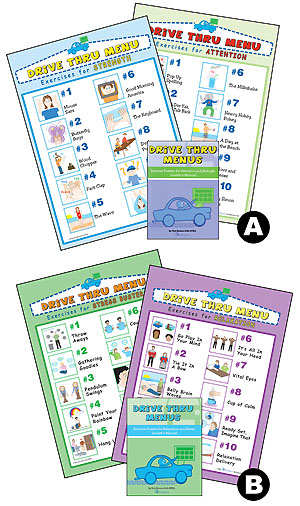 When a group of OTs get together to brainstorm, there’s bound to be some exciting “stuff” that is the outcome. Valorie Todd, MA, OTR/L and her school-based practice colleagues in the New York and New Jersey vicinity had a goal in mind. They wanted to devise a way to monitor quarterly progress in performance skills they identified as “OT goals” or “Areas of Need” on the IEP that was based on normative data. Valorie discussed the rubrics her group developed during her Therapro Saturday Seminar Series workshop on August 22, 2015 entitled: OT Rubrics for Fine Motor, Visual Motor and Handwriting Skills.
When a group of OTs get together to brainstorm, there’s bound to be some exciting “stuff” that is the outcome. Valorie Todd, MA, OTR/L and her school-based practice colleagues in the New York and New Jersey vicinity had a goal in mind. They wanted to devise a way to monitor quarterly progress in performance skills they identified as “OT goals” or “Areas of Need” on the IEP that was based on normative data. Valorie discussed the rubrics her group developed during her Therapro Saturday Seminar Series workshop on August 22, 2015 entitled: OT Rubrics for Fine Motor, Visual Motor and Handwriting Skills.
This seminar was the kick-off for the Fall Saturday Seminar Series and attracted about 60 attendees who listened closely, commented freely, and shared thoughts. Valorie and her colleagues were determined to conceive a way to assess a student’s performance against predetermined criteria, in which a student is measured against his own performance.
Valorie’s group identified 7 areas for assessment including:
- Postural Control
- Sensory Modulation
- Ocular Motor Skills
- Object Manipulation: Fine Motor/Hand Skills
- Controlled Tool Use: Color, Trace, Cut
- Design Copy: Graphics/Objects, and
- Handwriting.
In her seminar, Valorie discussed Object Manipulation, Controlled Tool Use, Design Copy, and Handwriting. Fine Motor Rubrics for Kindergarten and Grade 1 were identified.
Valorie offered a thoroughly researched plan on how to assess function and address the skill through worksheets that acknowledged how a student was expected to progress sequentially in each area. She made clear distinctions in skills expected of a kindergartner versus a first grader. For example, when assessing “Tracing,” specifically Pencil Control:
A kindergartner would receive a score of 4 if he:
- “Controls lines with min. errors 90-100%”
- “Stops/turns at corners (angles/arcs)”
A first grader would receive a score of 4 if he
- “Has good control within/on lines in all directions (90-100%)”
- “Starts/stops on dots with 1-2 errors”
Valorie’s rubrics were well-defined and can be easily replicated. She was very enthused about sharing her work, including worksheets, and encouraged therapists to use her rubrics and provide her with feedback so that the rubrics can further be developed with input and use over time. As a result, a meaningful assessment of quarterly progress can be obtained and insufficient areas can be addressed systematically and meaningfully before the student is due for the next standardized evaluation.
Attendees comments were very positive and encouraging:
“It was excellent! So much info, well related to school based OTs. This will be helpful in writing goals, tracking progress, presenting at meetings, and for my Teachpoint eval.” Amanda B., Occupational Therapist
“It helps so much to have these rubrics to support our clinical observations when IEPs are moving toward data driven/measurable goals and objectives. It will help with tracking and also guide thinking when working on skills.” Anonymous, Occupational Therapist
“Love the practicality of the Rubrics. Anything we can take away & use is terrific!” Amanda H., Occupational Therapist
“Looks at detail of task performance and observation of foundational skills which students have or need to build on.” Anonymous, Occupational Therapist
“I would recommend this seminar to a colleague because it was well researched and the information was very comprehensive. The material is very current and I can readily apply this information.” Anonymous, Occupational Therapist
Thank you, Val!
Filomena Connor, MS, OTR/L


 When a group of OTs get together to brainstorm, there’s bound to be some exciting “stuff” that is the outcome. Valorie Todd, MA, OTR/L and her school-based practice colleagues in the New York and New Jersey vicinity had a goal in mind. They wanted to devise a way to monitor quarterly progress in performance skills they identified as “OT goals” or “Areas of Need” on the IEP that was based on normative data. Valorie discussed the rubrics her group developed during her Therapro Saturday Seminar Series workshop on August 22, 2015 entitled:
When a group of OTs get together to brainstorm, there’s bound to be some exciting “stuff” that is the outcome. Valorie Todd, MA, OTR/L and her school-based practice colleagues in the New York and New Jersey vicinity had a goal in mind. They wanted to devise a way to monitor quarterly progress in performance skills they identified as “OT goals” or “Areas of Need” on the IEP that was based on normative data. Valorie discussed the rubrics her group developed during her Therapro Saturday Seminar Series workshop on August 22, 2015 entitled:  We were very happy to be invited back to the
We were very happy to be invited back to the  Therapro author of the
Therapro author of the  As therapists, teachers, and parents stopped by the Therapro exhibit, it was exciting to hear lots sharing of information about Therapro and its products. Therapists eagerly traded information about products they loved including: Therapro originals:
As therapists, teachers, and parents stopped by the Therapro exhibit, it was exciting to hear lots sharing of information about Therapro and its products. Therapists eagerly traded information about products they loved including: Therapro originals: